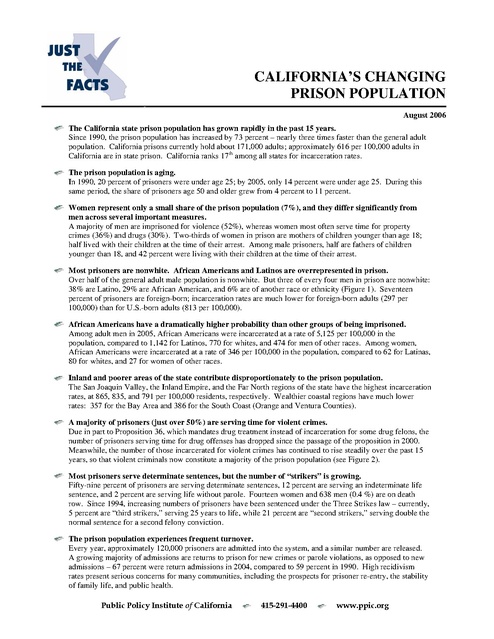Ppic Report on Cdc Population 2006
Download original document:

Document text

Document text
This text is machine-read, and may contain errors. Check the original document to verify accuracy.
CALIFORNIA’S CHANGING PRISON POPULATION August 2006 The California state prison population has grown rapidly in the past 15 years. Since 1990, the prison population has increased by 73 percent – nearly three times faster than the general adult population. California prisons currently hold about 171,000 adults; approximately 616 per 100,000 adults in California are in state prison. California ranks 17th among all states for incarceration rates. The prison population is aging. In 1990, 20 percent of prisoners were under age 25; by 2005, only 14 percent were under age 25. During this same period, the share of prisoners age 50 and older grew from 4 percent to 11 percent. Women represent only a small share of the prison population (7%), and they differ significantly from men across several important measures. A majority of men are imprisoned for violence (52%), whereas women most often serve time for property crimes (36%) and drugs (30%). Two-thirds of women in prison are mothers of children younger than age 18; half lived with their children at the time of their arrest. Among male prisoners, half are fathers of children younger than 18, and 42 percent were living with their children at the time of their arrest. Most prisoners are nonwhite. African Americans and Latinos are overrepresented in prison. Over half of the general adult male population is nonwhite. But three of every four men in prison are nonwhite: 38% are Latino, 29% are African American, and 6% are of another race or ethnicity (Figure 1). Seventeen percent of prisoners are foreign-born; incarceration rates are much lower for foreign-born adults (297 per 100,000) than for U.S.-born adults (813 per 100,000). African Americans have a dramatically higher probability than other groups of being imprisoned. Among adult men in 2005, African Americans were incarcerated at a rate of 5,125 per 100,000 in the population, compared to 1,142 for Latinos, 770 for whites, and 474 for men of other races. Among women, African Americans were incarcerated at a rate of 346 per 100,000 in the population, compared to 62 for Latinas, 80 for whites, and 27 for women of other races. Inland and poorer areas of the state contribute disproportionately to the prison population. The San Joaquin Valley, the Inland Empire, and the Far North regions of the state have the highest incarceration rates, at 865, 835, and 791 per 100,000 residents, respectively. Wealthier coastal regions have much lower rates: 357 for the Bay Area and 386 for the South Coast (Orange and Ventura Counties). A majority of prisoners (just over 50%) are serving time for violent crimes. Due in part to Proposition 36, which mandates drug treatment instead of incarceration for some drug felons, the number of prisoners serving time for drug offenses has dropped since the passage of the proposition in 2000. Meanwhile, the number of those incarcerated for violent crimes has continued to rise steadily over the past 15 years, so that violent criminals now constitute a majority of the prison population (see Figure 2). Most prisoners serve determinate sentences, but the number of “strikers” is growing. Fifty-nine percent of prisoners are serving determinate sentences, 12 percent are serving an indeterminate life sentence, and 2 percent are serving life without parole. Fourteen women and 638 men (0.4 %) are on death row. Since 1994, increasing numbers of prisoners have been sentenced under the Three Strikes law – currently, 5 percent are “third strikers,” serving 25 years to life, while 21 percent are “second strikers,” serving double the normal sentence for a second felony conviction. The prison population experiences frequent turnover. Every year, approximately 120,000 prisoners are admitted into the system, and a similar number are released. A growing majority of admissions are returns to prison for new crimes or parole violations, as opposed to new admissions – 67 percent were return admissions in 2004, compared to 59 percent in 1990. High recidivism rates present serious concerns for many communities, including the prospects for prisoner re-entry, the stability of family life, and public health. Public Policy Institute of California 415-291-4400 www.ppic.org Figure 1 Percentage of Adults in Prison and in the General Population, by Race/Ethnicity and Gender, 2005 Latino 100% 90% 80% 70% 60% 50% 40% 30% 20% 10% 0% 6 African American White 5 14 27 Other 16 39 44 44 29 7 38 35 Male Prisoners California Adult Males 29 7 28 34 Female Prisoners California Adults Females Sources: California Department of Corrections and Rehabilitation and Department of Finance data, 2005. Figure 2 Change in Offense Type, 1990-2005 90,000 80,000 70,000 Prisoners 60,000 Violent Crimes Property Crimes Drug Crimes Other Crimes 50,000 40,000 30,000 20,000 10,000 19 90 19 91 19 92 19 93 19 94 19 95 19 96 19 97 19 98 19 99 20 00 20 01 20 02 20 03 20 04 20 05 0 Source: California Department of Corrections and Rehabilitation data, 2005. Public Policy Institute of California 415-291-4400 www.ppic.org

